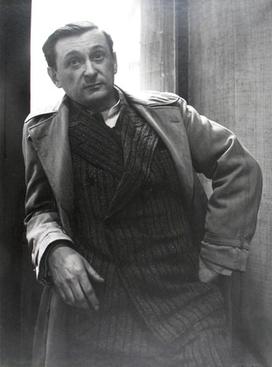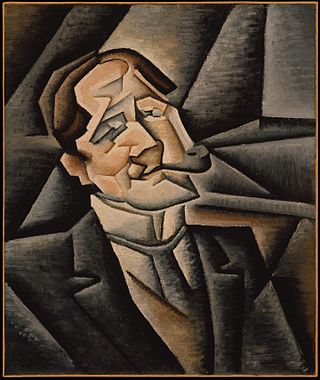
José Victoriano González-Pérez , better known as Juan Gris, was a Spanish painter born in Madrid who lived and worked in France for most of his active period. Closely connected to the innovative artistic genre Cubism, his works are among the movement's most distinctive.

Pablo Ruiz Picasso was a Spanish painter, sculptor, printmaker, ceramicist and theatre designer who spent most of his adult life in France. One of the most influential artists of the 20th century, he is known for co-founding the Cubist movement, the invention of constructed sculpture, the co-invention of collage, and for the wide variety of styles that he helped develop and explore. Among his most famous works are the proto-Cubist Les Demoiselles d'Avignon (1907) and the anti-war painting Guernica (1937), a dramatic portrayal of the bombing of Guernica by German and Italian air forces during the Spanish Civil War.

Cubism is an early-20th-century avant-garde art movement that revolutionized European painting and sculpture, and inspired related artistic movements in music, literature, and architecture. In Cubist works of art, the subjects are analysed, broken up, and reassembled in an abstract form—instead of depicting objects from a single perspective, the artist depicts the subject from multiple perspectives to represent the subject in a greater context. Cubism has been considered the most influential art movement of the 20th century. The term cubism is broadly associated with a variety of artworks produced in Paris or near Paris (Puteaux) during the 1910s and throughout the 1920s.

Jacques Lipchitz was a Cubist sculptor. Lipchitz retained highly figurative and legible components in his work leading up to 1915–16, after which naturalist and descriptive elements were muted, dominated by a synthetic style of Crystal Cubism. In 1920 Lipchitz held his first solo exhibition, at Léonce Rosenberg's Galerie L'Effort Moderne in Paris. Fleeing the Nazis he moved to the US and settled in New York City and eventually Hastings-on-Hudson.

Papier collé is a type of collage and collaging technique in which paper is adhered to a flat mount. The difference between collage and papier collé is that the latter refers exclusively to the use of paper, while the former may incorporate other two-dimension (non-paper) components. As the term papier collé is not commonly used, this type of work is often simply called collage.

Emilio Pettoruti (1892–1971) was an Argentine painter, who caused a scandal with his avant-garde cubist exhibition in 1924 in Buenos Aires. At the beginning of the twentieth century, Buenos Aires was a city full of artistic development. Pettoruti's career was thriving during the 1920s when "Argentina witnessed a decade of dynamic artistic activity; it was an era of euphoria, a time when the definition of modernity was developed." While Pettoruti was influenced by Cubism, Futurism, Constructivism, and Abstraction, he did not claim to paint in any of those styles in particular. Exhibiting all over Europe and Argentina, Emilio Pettoruti is remembered as one of the most influential artists in Argentina in the 20th century for his unique style and vision.

Three Musicians is the title of two similar oil paintings by Spanish artist Pablo Picasso. They were both completed in the summer of 1921 in Fontainebleau near Paris, France, in the garage of a villa that Picasso was using as his studio. They exemplify the Synthetic Cubist style; the flat planes of color and "intricate puzzle-like composition" giving the appearance of cutout paper with which the style originated. These paintings each colorfully represent three musicians wearing masks. Two of the musicians are wearing costumes of the popular Italian theater Commedia dell'arte.

María Blanchard was a Spanish painter. She was known for developing a unique style of Cubism.

Léonce Rosenberg was an art collector, writer, publisher, and one of the most influential French art dealers of the 20th century. His greatest impact was as a supporter and promoter of the cubists, especially during World War I and in the years immediately after.

La Femme à l'Éventail, or Woman with a Fan, is a painting by the French artist Jean Metzinger. The work was exhibited in 1914 at Moderni Umeni, S.V.U. Mánes, Prague. A 1914 photograph taken at the exhibition in Prague was published in the magazine Zlatá Praha showing Woman with a Fan hanging next to another work by Metzinger known as En Canot , 1913. Donated by Mr and Mrs Sigmund Kunstadter in 1959, Woman with a Fan forms part of the permanent collection in Gallery 391B at the Art Institute of Chicago, US.

Les Peintres Cubistes, Méditations Esthétiques, is a book written by Guillaume Apollinaire between 1905 and 1912, published in 1913. This was the third major text on Cubism; following Du "Cubisme" by Albert Gleizes and Jean Metzinger (1912); and André Salmon, Histoire anecdotique du cubisme (1912).

Femme au miroir, Femme à sa toilette or Lady at her Dressing Table, is a painting by the French artist Jean Metzinger. This distilled synthetic form of Cubism exemplifies Metzinger's continued interest, in 1916, towards less surface activity, with a strong emphasis on larger, flatter, overlapping abstract planes. The manifest primacy of the underlying geometric configuration, rooted in the abstract, controls nearly every element of the composition. The role of color remains primordial, but is now restrained within sharp delineated boundaries in comparison with several earlier works. The work of Juan Gris from the summer of 1916 to late 1918 bears much in common with that of Metzinger's late 1915 – early 1916 paintings.

Soldier at a Game of Chess, is a painting by the French artist Jean Metzinger. While serving as a medical orderly during World War I in Sainte-Menehould, France, Metzinger bore witness to the ravages of war firsthand. Rather than depicting such horrors, Metzinger chose to represent a poilu sitting at a game of chess, smoking a cigarette. The military subject of this painting is possibly a self-portrait.

Crystal Cubism is a distilled form of Cubism consistent with a shift, between 1915 and 1916, towards a strong emphasis on flat surface activity and large overlapping geometric planes. The primacy of the underlying geometric structure, rooted in the abstract, controls practically all of the elements of the artwork.

Juan Legua is an oil-on-canvas painting by Spanish cubist Juan Gris, created in 1911. It depicts a male sitter smoking a pipe and is one of Gris' earliest works in the cubist style. The work is in the collection of the Metropolitan Museum of Art, in New York.

Still Life with Checked Tablecloth is an early 20th century painting by Spanish Cubist artist Juan Gris. Done in oil and graphite on canvas, the painting depicts a table set with grapes, a bottle of red wine, beer, a newspaper and guitar. In addition, the composite image formed from these various objects can be seen as Gris' take on a bull's head. The work is in the collection of the Metropolitan Museum of Art.

Checkerboard and Playing Cards is an early 20th century drawing by Spanish cubist Juan Gris. Done in gouache, graphite, and resin on wove paper, the drawing depicts a table set with a checkerboard and playing cards. Gris' work is in the collection of the Metropolitan Museum of Art, in New York.

Still Life with a Guitar is an oil on canvas painting by Spanish cubist Juan Gris, from 1913. The work is in the collection of the Metropolitan Museum of Art, in New York, Gallery 905.

Violin and Playing Cards on a Table is an oil on canvas painting by Spanish cubist Juan Gris, from 1913. The work is a still life, a typical motif for the cubists. It is in the collection of the Metropolitan Museum of Art, in New York.

The Anisette Bottle is a 1914 painting by Juan Gris, now in the Museo Nacional Centro de Arte Reina Sofía in Madrid. It shows a bottle of anisette, specifically the Spanish brand Anís del Mono, with the names of Badalona, Madrid and Paris, all linked with the leaders of the Cubist movement, namely Gris himself, Pablo Picasso and Georges Braque.





















